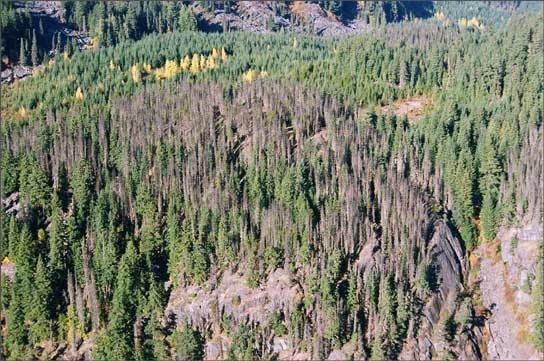By Allen Best
FRISCO, Colo. – Colorado Sen. Ken Salazar last week
showed why he has gone from a farm without electricity as a boy to now becoming
one of the nation’s more powerful politicians. He can turn a phrase,
galvanizing an audience, even at long distance.
Speaking by telephone last week to 200 people assembled at a
forum in Frisco, he likened the forests of north-central Colorado to a potential
“Katrina of the West.” The aging, beetle-weakened forests could yield massive
fires similar to those of 2002, he went on to say. The phrase found its way
into the front page Denver’s Rocky Mountain News.
The forum had been organized by Salazar’s office and others as
a way to highlight potential answers to the fact that trees from Vail to Dillon
to Winter Park and Grand Lake are dying in large numbers. The turnout at the
forum caught organizers by surprise. People spilled out into the street, and even
at the end of a six-hour session it was standing-room only.
However, the answers are not overly obvious, nor is there even
agreement about the problem. The most immediate blame is assigned to bark
beetles, which exist in all forests at all times, but brewing to epidemic
portions periodically as conditions ripen. They made a major foray into this
same region in the early 1980s, but then began waxing in numbers about 1996.
Unchecked by sustained cold temperatures, they continue to spread in forests of
lodgepole pine trees that are now about 110 years old, their maturation
threshold, and hence naturally more vulnerable to forests pests. Other beetles
are also making some inroads into spruce and fir forests, which have longer,
sometimes 350-year lifecycles.
Beetle-killed forests now stretch from Alaska through British
Columbia and as far south as California. While in B.C. the issue has generally
been seen as a forestry concern, in the Colorado Rockies it has caught the
attention of the ski industry, which is a significant contributor to state
revenues.
With rust-coloured trees now bordering condominiums and homes,
Colorado mountain towns and valleys are becoming worried — so worried
that they have shed traditional mistrust of loggers. Even a half-dozen years ago,
few people could be rounded up to defend timber sales near ski communities. But
last winter, the ski towns dispatched a delegation to Washington D.C. to see if
federal rules could be revised, to better accommodate below-cost timber sales.
But the federal government, with tax cuts aplenty while
engaging in a foreign war, has little money for administering timber sales.
Too, there are few sawmills left in Colorado, causing exorbitant transportation
costs. Loggers complain they got shut out of the woods during the Clinton
years, although the truth is far more muddled and complicated by international
economies.
One idea being explored increasingly is that of biomass
burners. At last week’s session in Frisco, people heard about several such
burners now in operation or planned to convert wood into electricity or heat.
One such burner is being planned near Frisco; others are being investigated
along the I-70 corridor.
But no one thing will be the answer, many observers say. And
many scientists warn that more logging alone won’t be the answer. Speaking at a
session in Frisco, Tania Schoennagel pointed out that intensive, long-term and
widespread logging in parts of British Columbia have not had any effect on
spread of pine beetles in large areas.
“Those findings,” notes the Summit Daily News, “may call into
question the assumption that Colorado can log its way back to healthy forests.”
Scientists and researchers during the last several years have
trying to stress that it’s an over-simplification to simply say that beetle-killed
trees equal the potential for catastrophic danger. This point was stressed in a
report from Colorado State University that suggested that bark beetles will
actually be good for the forests.
Rick Cables, the regional administrator for the U.S. Forest
Service, bridled at that suggestion. But he did concede that humans could do
only so much to blunt the effect of beetles — and the potential for fire.
“The beetle epidemic is caused by major forces beyond our control. We can no
more stop it than we can stop a hurricane.”
The challenge is to protect critical values like home, roads, and power lines, he added.




